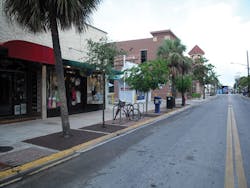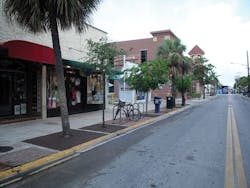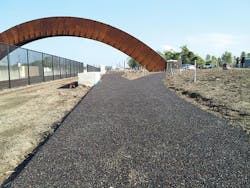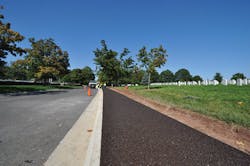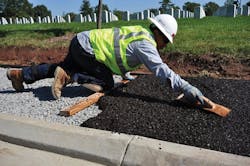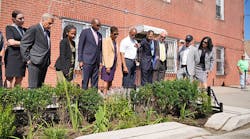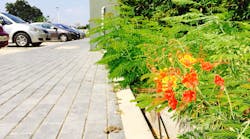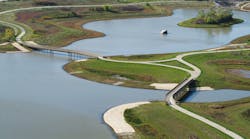By Art Haddaway, WaterWorld Editor
At some point, it’s going to rain - and when it does, stormwater will flow through the streets of populated cities and neighborhoods. For many municipalities, heavy downpours can cause flooding and damage in certain areas and produce runoff that collects impurities and debris, potentially contaminating local waterbodies and impacting the environment.
For many municipalities, managing stormwater - and managing it properly - can be a challenge, especially when it comes to reducing overflows while improving water quality and meeting more stringent and ever-changing regulations in the process. However, many communities are finding that new approaches such as green infrastructure and low-impact-development projects ultimately serve as best management practices and are contributing to better stormwater treatment and mitigation.
One goal is to repurpose stormwater in a way that reinvests back into the community and helps benefit the local economy and surrounding environment. With techniques that involve everything from separation to storage/harvesting to infiltration, municipalities have a wide range of options to choose from. One example of how stormwater is being put to good use is through the use of permeable, or porous, pavement.
Growing in popularity, permeable pavement - an alternative to traditional asphalt or concrete surfaces - captures stormwater and allows it to drain through the porous surface, where it is treated, stored and eventually infused into the ground or subsoil. This process is not only effective for reducing runoff but can also help cities control pollutants, recharge groundwater, comply with federal and state stormwater requirements, and even support enhanced tree growth by expanding root space beneath the ground.
According to the Green Building Alliance, the appearance of permeable pavement is often similar to asphalt or concrete, but its material consists of cement, a coarse aggregate and water, with little to no fine aggregates. It incorporates several voids that allow water to flow through. When compared to the required 3- to 7.5-percent void percentage of impermeable, or non-porous, pavement, this high void ratio lets stormwater run easily through the material, with typical flow rates ranging from 2 to 18 gallons per minute.
“Permeable pavements have been around for decades, but they’ve really only been looked at seriously for stormwater management maybe in the last 10 to 15 years,” said Tom Ballestero, director of the University of New Hampshire Stormwater Center. “The big difference is [that] the former applications were a permeable pavement in which the top surface was permeable and then below was an impermeable layer. Now, the more classic view of a permeable pavement is a full-depth permeable system - so the top layer is permeable, the layer below that is permeable, and the layer below that is permeable.”
Permeable pavement is usually installed at roads, walkways, parking lots, and recreational areas, particularly in highly urbanized locations where traffic (driving, bicycling, walking, etc.) is consistent. In addition, the technology eliminates the need for other stormwater management devices such as swales or retention ponds - thus creating more efficient land use - and is also used to mimic or preserve a site’s natural setting. As such, the advantages of the technology are threefold: it successfully manages stormwater runoff, provides a resilient thoroughfare for transportation, and enhances the surrounding landscape.
Currently, there are many municipalities throughout the U.S. incorporating permeable pavement into their districts. These cities have resolved to tackle common challenges associated with stormwater, in addition to transportation and vegetation, and are taking proactive measures to achieve this goal.
Seattle, Wash., and Key West, Fla., for example, are utilizing the support of permeable pavement for a variety of applications, including native trails, median areas, tree surrounds, and storefronts. With a product called KBI Flexi®-Pave, these cities are mitigating stormwater while experiencing less cracking or settling on the surface, improved groundwater quality and reduced overall costs - from operational to total ownership.
KBI Flexi-Pave is manufactured by KB Industries (KBI), who brought its flexible porous paving to market in 2001. “There’s a bit of an awakening going on within many of the older cities,” said Steve Hides, president of KBI. “A lot of cities are looking at a retrofit opportunity to disconnect hard surface within the urban environment to reduce the rate and volume of runoff into the existing combined sewers and stormwater sewer systems. What we’re [also] seeing more of is opportunities for new construction, where facility owners are looking to reduce the impervious area. So basically they’re looking to contain everything within the project site…they’re looking wherever they can to put that water back into the ground again.”
In Key West, tree surrounds using Flexi-Pave reduce stormwater and keep trees healthy. The project has served as a replacement for traditional tree surround alternatives, such as metal grates and guards, and has saved Key West over $250,000 as a result. Likewise, Seattle installed Flexi-Pave in June of this year at 14 tree surrounds across the region at zero charge as part of a demonstration project and is continuing to experience similar outcomes as it relates to cost savings and runoff reduction.
“It’s called ‘Flexi-Pave,’ [because] it’s flexible; it doesn’t lift and rise like a tree grate would do due to root movements, so it reduces the tripping hazard,” said Hides. “One of the key attributes of Flexi-Pave is the porosity and the percolation rate of the material - approximately 2,400 gallons per hour per square foot. So it allows the ground to absorb a significant amount of water [for] replenishing the tree roots. Where the ground conditions are favorable … then it makes more sense to put [this water] back into the system.”
In Largo, Fla., Flexi-Pave was used on a historic native plant trail to remedy standing water issues during rain events. In Terra Haute, Ind., it was used at a high-traffic median area, making it the first community in the state to use a recyclable product for that purpose. Other Flexi-Pave projects include tree surrounds in Atlanta, Ga.; a waterside trail along the Mississippi River in New Orleans, La.; a sidewalk system at Arlington Nation Cemetery in Washington, D.C.; and more recently an asphalt trail around Old Faithful in Yellowstone National Park.
Many of these projects - all of which are ADA compliant - were made possible through KBI’s Green Partnership Program (GPP), a unique training, certification and purchasing arrangement designed to teach participants (utilities, municipalities, etc.) on-site how to plan, order, prepare, and install up to four GPP-qualified KBI products on their own. This ultimately helps cities to save labor costs and install the technology in a discretionary timeframe.
“It enables [communities] to install the product themselves without going out to an outside contractor,” said Hides, “so it gives them additional flexibility in terms of how and when they want to address these issues.” KBI also offers tree-surround demonstration projects on a no-cost/no-risk basis. “So a lot of municipal customers are coming to us so they can trial [Flexi-Pave] and see how effective it is in a certain area.”
It’s estimated that the market for permeable pavement is expanding and will continue to grow, Ballestero said. “Invariably, green infrastructure is coming in cheaper than conventional infrastructure for new development,” he noted. “When you look at an entire new development and all the drainage structure - conventional versus green - what you find is that for green infrastructure, you don’t require catch basins, curb, gutter, or storm sewers. Nationwide, the EPA has tracked a number of sites, and they’re typically coming up with 10- to 20-percent cheaper [for green infrastructure], which is matched by our own research. In the instance of a commercial development, it was 9-percent cheaper to do green infrastructure, including the porous [pavement].”
More WaterWorld Current Issue Articles
More WaterWorld Archives Issue Articles
